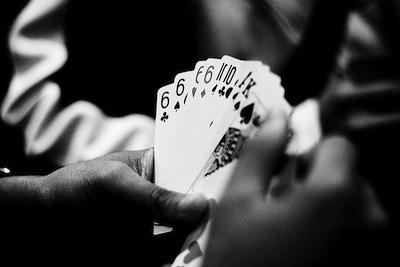[Brilliant Blog] Probability II

[This is targeted at a level 3 student.]
This is a continuation of the Probability blog post.
In our first blog about probability, we focused on sets of events that are mutually exclusive. In this blog, we will expand to look at events which are not mutually exclusive, and some techniques we can use to solve various types of probability questions.
One of our best tools to solve questions dealing with events that are not mutually exclusive is the Principle of Inclusion and Exclusion. We can formulate a probabilistic version of this principle.
Probabilistic Principle of Inclusion and Exclusion
And in general, techniques that we use when we solve counting problems are also what we often use when we solve probability problems. If we can find nice descriptions of the set we are interested in, and of the whole set of possibilities, we can use counting techniques to count both. We have seen examples of how the Rule of sum, Rule of Product have been used to calculate probabilities.
When solving problems about coin flips, the number of ways to get a certain number of heads or tails is always a binomial coefficient. We can often use properties of binomial coefficients to help solve problems of this type.
As in counting problems, it is sometimes easier to determine the probability of the complement of what you are looking for. If you roll two dice and want to know what the probability of rolling a sum that is larger than 3, you could add the probabilities of getting together, or you could add the probabilities of getting (the complement) and subtract this value from 1.
Worked Examples
1. A card is drawn from a standard deck of cards. What is the probability that it is a queen or a heart?
Solution: We can use the Probabilistic Principle of Inclusion and Exclusion to calculate this. Let be the event that the card is a queen, and be the event that the card is a heart. Then . Since there are 13 different ranks of cards in the deck, , and since there are 4 suits in the deck, . There is only one card that is both a queen and a heart, so . So .
2. A fair coin is flipped 11 times. What is the probability that the number of heads was even?
Solution: The number of ways to get an even number of flips is We can use the identity to see that the total number of ways is In total there are different possible results, so the probability is .
3. What is the probability that after rolling a die 3 times you see at least one 6?
Solution: We could do this calculation using the principle of inclusion and exclusion, but what happens if 3 is replaced by 10 in the original question? The calculations would get really ugly, really fast. Instead, we can efficiently calculate the complement probability. The probability that we do not see 6 after rolling 3 times is simply , since each roll is independent and there is a chance that we don’t get a 6 on each roll. So the probability that we do see a 6 is . If we replaced 3 with any number in the question, we can easily see how our answer will change.
Test Yourself
An integer is chosen at random from 1 to 100 inclusive. What is the probability that it is both a multiple of 2 and a multiple of 5?
An integer is chosen at random from 1 to 100 inclusive. What is the probability that it is either a multiple of 2 or a multiple of 5?
Eight six-sided dice are rolled. What is the probability that at least two of the dice showed a 1?
10 six-sided dice are rolled. What is the probability of having at least 3 dice showing the same number?
(*) A fair coin is repeatedly flipped. What is the probability that 3 consecutive heads will appear before two consecutive tails?
Easy Math Editor
This discussion board is a place to discuss our Daily Challenges and the math and science related to those challenges. Explanations are more than just a solution — they should explain the steps and thinking strategies that you used to obtain the solution. Comments should further the discussion of math and science.
When posting on Brilliant:
*italics*or_italics_**bold**or__bold__paragraph 1
paragraph 2
[example link](https://brilliant.org)> This is a quote# I indented these lines # 4 spaces, and now they show # up as a code block. print "hello world"\(...\)or\[...\]to ensure proper formatting.2 \times 32^{34}a_{i-1}\frac{2}{3}\sqrt{2}\sum_{i=1}^3\sin \theta\boxed{123}Comments
Just wondering, beside problem solving can probability helps in becoming a good gambler. To put it another way are mathematicians good gamblers? I am not pursing to become a gambler anyway lol.
Log in to reply
All games played at casinos have a negative expected net cost to the player. This means that on average everyone will lose - this is how casinos make money. Understanding the probabilities of a game such as poker will increase your odds of winning, but most poker players are not mathematicians, they just understand the probabilities of being dealt various hands and winning in various scenarios.
Would this work for 'solving a brilliant math problem'?
Log in to reply
Yes, it does. Try it.